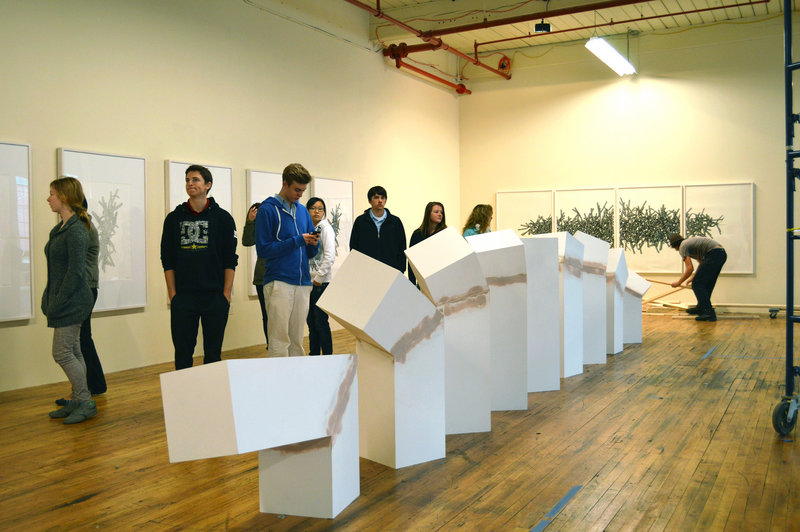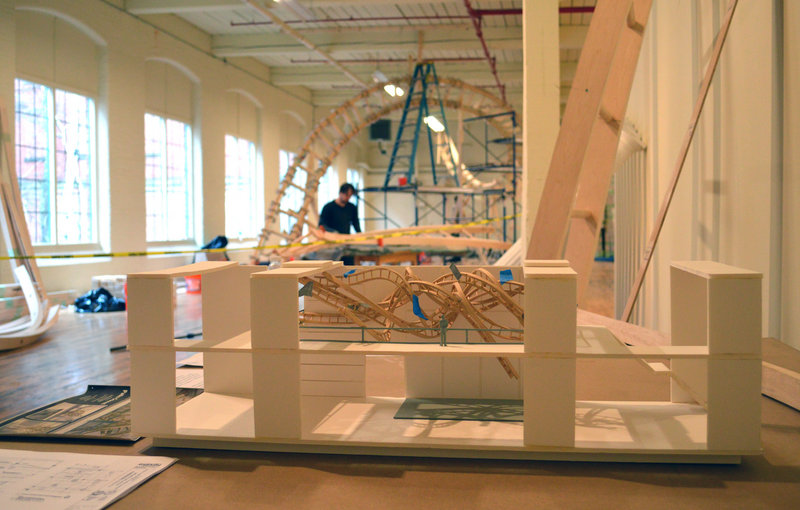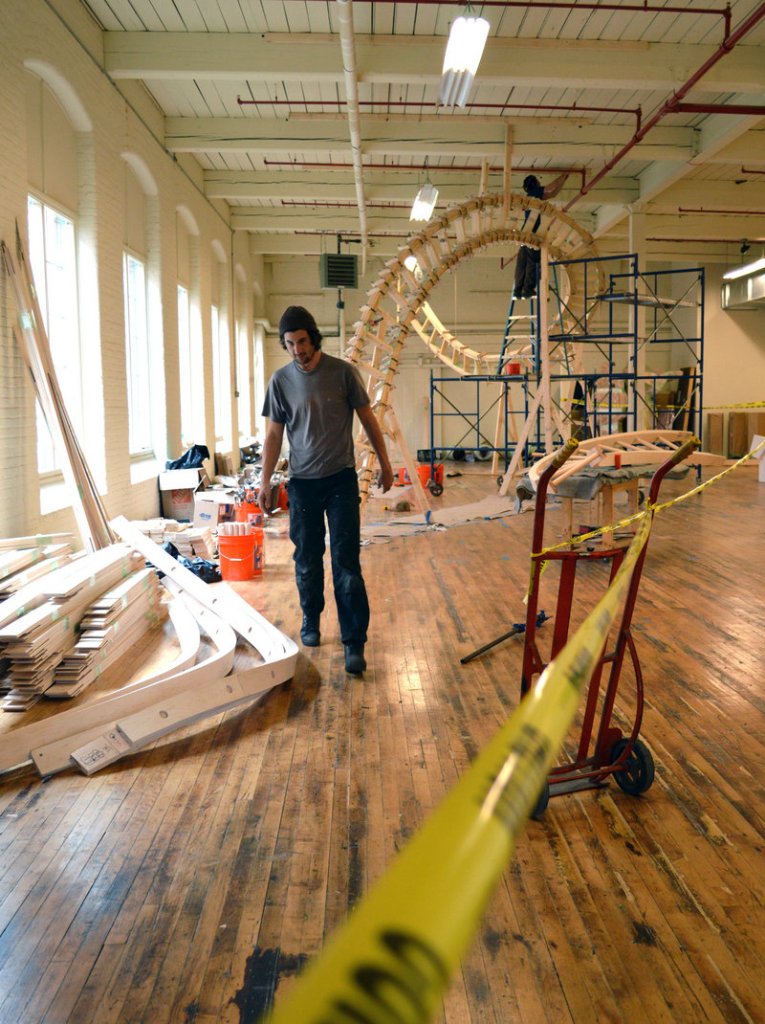Aaron Stephan’s “Paths” at Coleman Burke Gallery in Brunswick is amazing.
But it doesn’t look like an exhibition; it’s a work site. The huge gallery is filled with tools, materials, dust and the elements of a giant construction project.
The completed art brought for display is hung around the corner out of immediate sight, leaned unceremoniously against a wall or still wrapped in labeled butcher paper.
Some of this is ironically hilarious. For example, there are some raw wood shipping crates shaped like giant cartoon people. The crates are the works of art themselves, but when casually placed next to actual crates, how could you tell?
Then there is that unique Coleman Burke thing: There is no ennui-groomed and screen-occupied hipster desk-camped near the entrance casting occasional high-eyebrowed aspersions in your direction.
This makes all the difference, particularly when the artist is working on site. The sensation is of walking not into a gallery but into a busy, working studio that looks and smells like a woodworking shop deep in the throes of a major project.
Stephan’s “Do Not Cross” yellow police tape diagonally slices the 200-foot room in half and has a Janus-faced welcoming effect. By telling you where you can’t go, you figure out where you can.
It’s easy enough to understand when you see a 60-foot wooden structure writhing 15 feet into the air. Covered with scores of wooden clamps and surrounded by scaffolding, ladders and tools, it’s like someone hired M.C. Escher to create an architectural roller coaster out of giant wooden ladders twisted into DNA shapes.
Yet the monstrous wooden form refuses to be anything but alive.
And it has to be alive. It has a tell-tale pulse: Stephan is on the clock to complete the piece (titled “Paths Crossed”) by May 24 — which is when the show ends with its opening reception.
This might sound like some pretentious conceptual art gesture, but it simply makes sense to have the public reception once the sculpture is completed and before it’s shipped to its permanent home in the lobby of Indianapolis’ Wishard Hospital.
The ancillary artworks in the gallery add (and benefit from) a sense of vital conceptual heft. The scope of the sculpture taking shape, however, is most easily understood by looking at the 3D architectural model near the gallery entrance.
Still, any artist with public art project experience will tell you that fabricating the sculpture only comes after years of competitions, presentations, site visits and enough bureaucratic hoop-jumping to over-saturate Kafka’s imagination. The construction began three weeks ago — four full years after the clock started ticking.
As a public sculpture, “Paths” is very strong. (Well, it should be once it is completed and installed.)
While projects such as Portland’s now-removed “Tracing the Fore” remind us to focus on substance rather than propositions, there is enough material presence — designs, models, finished sample sections, etc. — to show us precisely what the sculpture will be.
I generally like Stephan’s public sculpture, but I think “Paths” will soar past any of his previous work for several reasons.
Sculpturally, it is sophisticated, exciting and complex. As craft, it’s substantial and impressive. I particularly like the way Stephan uses woodshop techniques to elicit high-tech forms; in a hospital, they will evoke DNA or even IT data streams.
However, Stephan’s real step forward involves content and the viewer experience. Instead of a conceptual rebus to solve, “Paths,” as the title suggests, delivers ideas about means rather than meaning.
“Paths” suggests a new mode of the “sublime” to go along with Kant’s vast perception beyond comprehension (think a starry night sky) or Burke’s inconceivably horrific (think Goya’s “Saturn devouring his children” or horror movies): the technological sublime (think the possibilities of DNA or the entire Internet).
In short, Stephan is tapping metaphysics — the inconceivable or the ineffable. In culture, this has generally fallen to religion or spirituality as elements of faith. For classical philosophy, this has long been a fly in the ointment.
In a statement, Stephan cites Ludwig Wittgenstein’s treatise in which the Austrian philosopher posits that any discussion of mysticism by definition falls apart immediately.
Ironically, “Paths” can be seen as an illustration of “Wittgenstein’s Ladder” — the proposition that ideas used as means to other ideas are then discarded as one discards a ladder after using it (think staircase).
If so, then Stephan is making the don’t-go-there case that some things aren’t supposed to be understood or empirically provable (think New England transcendentalism).
With “Paths” (and following Wittgenstein’s saying/showing distinction), Stephan makes a compelling case that you don’t always have to explain to understand. So, no, there will not be a quiz.
What matters most with “Paths” is the public experience of the studio. In fact, seeing the clamps and tools that will later be discarded actually helps. Also, the artist and his crew.
But on a basic level, this is an opportunity to see what really goes into making an ambitious, large-scale public sculpture.
It’s even more important to visit this show because the days of the Coleman Burke Gallery appear to be numbered.
What I particularly like about “Paths,” however, is the sense of accomplished professionalism. This is no Island of Misfit Toys — it is real people working under the glow of a green light.
“Paths,” after all, has a deadline and a destination.
Freelance writer Daniel Kany is an art historian who lives in Cumberland. He can be contacted at:
dankany@gmail.com
Send questions/comments to the editors.





Success. Please wait for the page to reload. If the page does not reload within 5 seconds, please refresh the page.
Enter your email and password to access comments.
Hi, to comment on stories you must . This profile is in addition to your subscription and website login.
Already have a commenting profile? .
Invalid username/password.
Please check your email to confirm and complete your registration.
Only subscribers are eligible to post comments. Please subscribe or login first for digital access. Here’s why.
Use the form below to reset your password. When you've submitted your account email, we will send an email with a reset code.